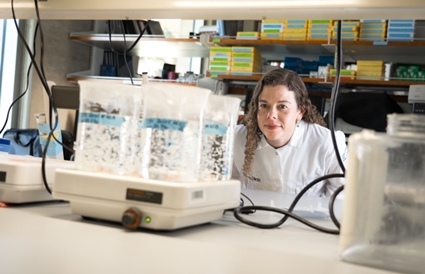|
NOVIDADES
Currently, there is no established treatment to repair damage to cardiac tissue following a heart attack, where the resulting scar tissue can diminish muscle function and cause heart failure. Ventrix, a University of California San Diego spin-off, has now successfully conducted a first-in-human trial of an injectable hydrogel – VentriGel – designed to repair damage and restore cardiac function in heart failure patients who previously suffered a heart attack (JACC Basic Transl. Sci. 10.1016/j.jacbts.2019.07.012). The FDA-approved Phase 1 clinical trial is the first to test a hydrogel designed to repair cardiac tissue. It is also the first demonstration of using a hydrogel made from extracellular matrix (ECM), the natural scaffolding in which cells reside, in any tissue in patients. This is significant as preclinical studies have shown ECM hydrogels to potentially be effective for other conditions, such as poor blood circulation caused by peripheral artery disease. Invented by Karen Christman at UC San Diego and her team, VentriGel is made from cardiac connective tissue taken from pigs and stripped of heart muscle cells. The decellularized tissue is then freeze-dried and milled into powder form, and then liquefied into a fluid that can be easily injected into heart muscle via a minimally invasive procedure. Once it reaches body temperature, the liquid turns into a semi-solid, porous gel.  Karen Christman from UC San Diego led the development of VentriGel, a hydrogel to repair heart tissue after heart attacks. (Courtesy: David Baillot/University of California San Diego)
The primary aim of the trial was to evaluate the safety and feasibility of transendocardial injections of VentriGel in patients with moderate left ventricle dysfunction following a heart attack. The team examined seven patients who had suffered a heart attack within the past year, and eight who had a heart attack one to three years previously. Each patient received up to 18 injections of VentriGel into the damaged region, via a catheter guided by a cardiac mapping system. The researchers followed the patients for six months after treatment and found that the hydrogel could be safely injected into the patients. Overall, VentriGel was well tolerated, with all patients completing the full follow-up. The team report that no adverse event was definitely related to VentriGel or the mapping/injection procedure. One major and one moderate adverse cardiac event, both in the first patient treated, were possibly related to the treatment. A secondary objective was investigation of the preliminary efficacy of VentriGel, by measuring changes in various parameters from baseline to three and six months after treatment. For example, patients performed a six-minute walk test as a measure of functional exercise capacity. In the total cohort, VentriGel treatment significantly increased the maximum walk distance with time post-injection. The patients also took a heart function assessment and a heart health questionnaire, as well as undergoing MR imaging, at baseline and three and six months later. “Although the study was designed to evaluate safety and feasibility and not designed to show whether VentriGel effectively helps improve heart function, we observed some improvements in patients,” explains Christman. “For example, patients could walk longer distances. We also observed signs of improving heart function in patients who experienced a heart attack more than one year prior to treatment.” Ventrix is now gearing up for a Phase 2 clinical trial that will expand on this successful first-in-human study. The team is planning a larger, randomized trial that will evaluate how effectively VentriGel can improve cardiac function and quality-of-life for patients experiencing heart failure. By Tami Freeman. Physics World. Posted: Sept 12, 2019. |
|||||||||||||||||||||||||